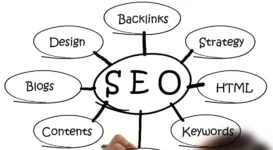There’s more to a great web design than the aesthetic appeal it offers to your web presence. Besides embellishing or beautifying your web pages, a great design goes a long way to determine how effective your SEO campaign is going to be.
To understand how the effect comes about, it’s important that you first get your head wrapped up around the three things that together play a very important role in determining how well your site ranks in the SERPs–and that is; the site’s layout and navigation, loading speed (commonly abbreviated as UX), and lastly, on-site optimization.
The Sites Layout
It’s Google’s job to ensure their users get only the best listings in the SERPs. While they could easily do this by relying on keywords, they eventually found out that keywords weren’t effective enough a method to employ. So they decided to throw in two more gauging indicators—to wit, bounce rate and the time spent on site.
– Bounce rate
Bounce rate is the rate at which visitors click on the back-button or close your site upon landing on it. The more the rate, the lower the value of your website.
For a lower bounce rate, first your website design has to ensure it delivers on all the promises it made on the search engine. In other words, people should land straight to the kind of content they were hoping to find upon clicking on the search results.
If the link redirects to another link or leads to a page that’s filled up with other links, then users are likely to end up hitting the back button or closing the page, thus leading to a higher bounce rate, which in turn ends up lowering your ranking in the SERPs.
– The time spent on site
Those lucky enough to have escaped the bounce rate now have the second design-related SEO hurdle to jump over–the time the user gets to spend on the site. Quite literally, the more your users lurk around your site, the more you’re likely to end up ranking high in the search pages.
A great design makes it easy to keep your viewers around by making related posts visible to them or by suggesting other interesting posts for them to read. But NOT in a way that will come off as intrusive or serve as a distraction.
A design that looks like it was built in the 90s won’t certainly help to keep readers around.
Another thing to look at is the value your users are likely to get when they stop by your site. Is the content strategically placed or do users have to always click on the next page to continue reading the rest of the article?
The load time of both your site and its pages
Your site’s loading speed is the amount of time it takes for the browser you’re using to receive the first byte of information from your web server.
This NEVER used to be an issue until recently when Google decided to use it as one of the signals they use to rank pages in the search engine.
The web design you choose will determine how fast or slow your site loads and in the process get to affect its search engine ranking.
Parallax Design
A parallax design occurs when a complete website tries to load up within a single web page. The entire idea can be both outstanding and unique, especially when there’s a remarkable background, adding up to the overall aesthetic appeal of your website. Plus, it could contain a menu that might come in handy when jumping to a particular point on the page.
However, the content placed in such a page risks confusing Google’s ranking algorithms to a point that it may actually fail to understand what the type of content the page is all about, something that could end up having an adverse effect on how the overall site or page is ranked in the SERPs.
The Wrap Up
There’s no doubt that your web design will be impacting on how well your site ranks in the search engine. If your website is complex, such that users have a problem navigating through, then the impact experienced could be negative as opposed to a site that’s both simple and easy to navigate or browse through.








